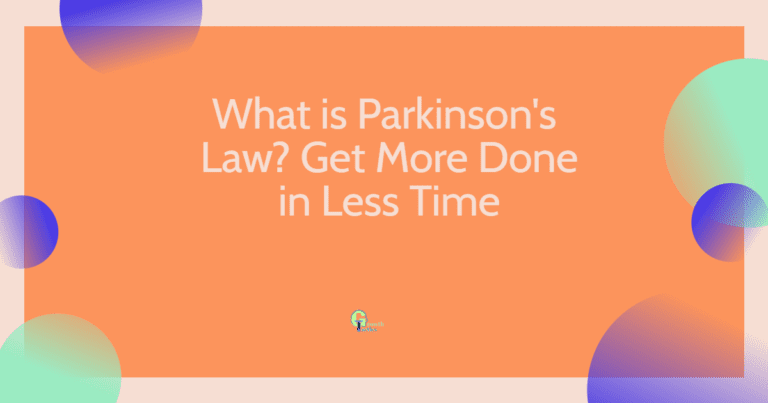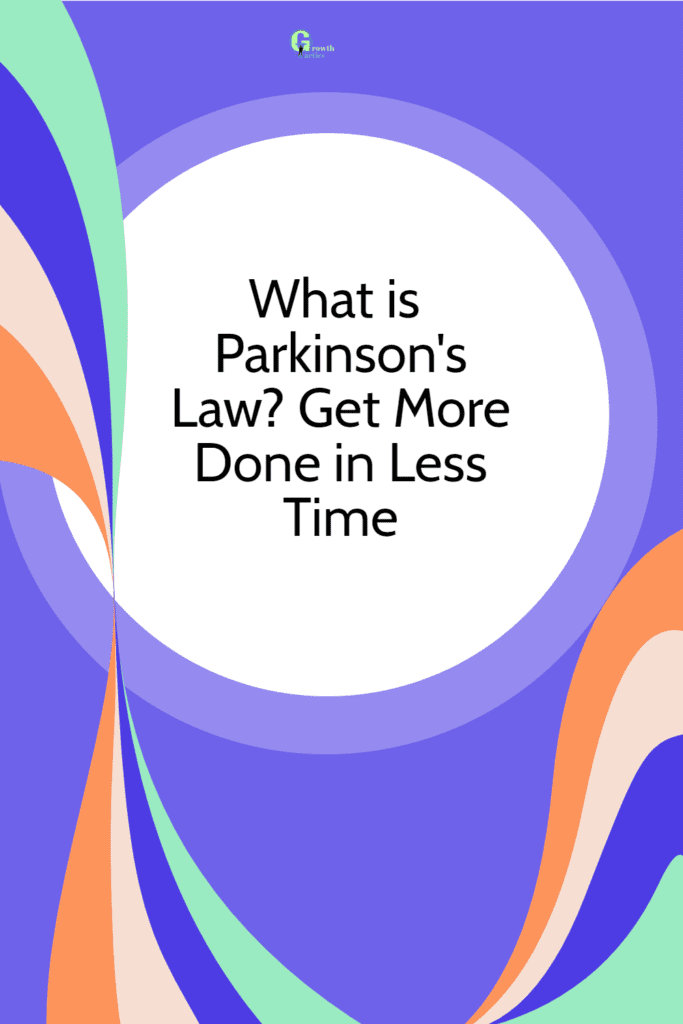Do you often find yourself wishing there were more hours in a day? Do you feel overwhelmed with your never-ending to-do list? Well, you’re not alone! Many of us struggle with managing our time effectively and getting things done efficiently. Fortunately, there’s a concept called Parkinson’s Law that can help us tackle this problem head-on and make the most of our precious time. In this blog post, we’ll dive into what Parkinson’s Law is and how you can harness its power to supercharge your productivity and get more done in less time. Let’s get started!
Jump To Section
Understanding Parkinson’s Law
So, what is Parkinson’s Law? Parkinson’s Law, coined by British author Cyril Northcote Parkinson in 1955, states that “the amount of work expands to fill the time available for its completion.” In simpler terms, if you give yourself a long time frame to complete a task, it’s likely to take longer than necessary. Have you ever noticed that a task that should take an hour somehow ends up taking the entire afternoon? That’s Parkinson’s Law in action.
But why does this happen? It all comes down to human psychology. When we have an abundance of time allotted, we tend to become less focused and more prone to distractions. We may procrastinate, feel less urgency, or engage in time-wasting activities. However, when we impose time constraints and deadlines, our minds kick into high gear, and we become more efficient and effective. So, essentially, Parkinson’s Law is a reflection of our ability to adapt and respond to the time we have available.

Parkinson’s Law Examples
Example 1: Work Tasks
When it comes to work tasks, Parkinson’s Law is in full effect. It states that work tends to expand to fill the available time. So, even if you have a relatively simple task that should only take an hour, if you give yourself the whole day to complete it, chances are it will take you the whole day!
Let’s say you have to write a report for your boss by the end of the day. If you allocate the entire workday for this task, you’ll find yourself getting distracted, taking longer breaks, and maybe even doing some online shopping. Before you know it, the day is over, and you’re still struggling to finish the report!
So, what can you do to combat Parkinson’s Law and be more efficient with your time? One trick is to set strict deadlines for yourself, even if they seem a bit challenging. By imposing a time constraint, you’ll be more focused and motivated to get the task done without unnecessary delays.
Example 2: Meetings
We’ve all been there – sitting in a never-ending meeting that drags on and on, eating away at our precious time. Well, Parkinson’s Law applies to meetings as well. It states that meetings tend to occupy the entire duration scheduled, regardless of the actual necessity.
Imagine you have a team meeting that’s scheduled for an hour. You could have easily covered all the important topics in 30 minutes, but somehow the discussion stretches, and before you know it, the one-hour mark is approaching. By recognizing Parkinson’s Law, you can take steps to make meetings more efficient.
One approach is to set a predefined agenda and stick to it religiously. This helps keep the conversation on track and ensures that everyone stays focused. Also, consider reducing the allocated time for meetings. If you normally schedule an hour, try scheduling 45 minutes instead. This creates a sense of urgency and encourages participants to get to the point.
Example 3: Project Deadlines
When it comes to projects, Parkinson’s Law has a sneaky way of creeping in and causing delays. You might think you have plenty of time to complete a project, but as the deadline approaches, you suddenly find yourself scrambling to finish.
Let’s say you have a month to complete a project. You might start off by taking it easy in the beginning, thinking you have all the time in the world. As a result, you procrastinate and do other less important tasks. Then, as the deadline looms closer, panic sets in, and you’re left with limited time to complete the project. Recognizing Parkinson’s Law in this scenario can help you prevent delays and manage your time effectively.
To combat the creeping effect of Parkinson’s Law on project deadlines, it’s essential to set mini-deadlines throughout the project timeline. Breaking the project into smaller tasks with their own due dates helps you stay on track and avoid that last-minute rush.
Example 4: Personal Time Management
Parkinson’s Law doesn’t just apply to work-related tasks and deadlines; it can affect our personal lives too. Have you ever noticed how a simple household chore can end up taking hours when you have a whole day to complete it? That’s Parkinson’s Law in action!
Let’s say you have a day off to clean your house. Instead of getting right to it, you catch up on your favorite TV show, spend an excessive amount of time on social media, and maybe take a long lunch break. As a result, the cleaning task gets pushed back, and you end up rushing at the last minute to tidy up before the day is over.
If you want to make the most of your personal time and overcome Parkinson’s Law, consider setting specific time blocks for different tasks. Dedicate a focused amount of time to each task, such as 30 minutes for cleaning, 1 hour for leisure activities, and so on. This will help you stay disciplined and avoid wasting your free time.

Applying Parkinson’s Law for increased productivity
Now that we understand Parkinson’s Law, let’s explore how we can use it to our advantage and boost our productivity. Here are some practical strategies:
Recognizing time wastage and procrastination
The first step in embracing Parkinson’s Law is to become aware of the time-wasting activities and procrastination traps that hinder our productivity. Social media scrolling, excessive emailing, and multitasking are all common culprits. By identifying these behaviors and consciously curbing them, we can reclaim valuable time and redirect it towards more meaningful tasks.
Setting realistic deadlines and time limits
One of the keys to making Parkinson’s Law work for you is setting realistic deadlines and time limits for your tasks. Break down your projects into smaller, more manageable portions, and allocate a specific amount of time for each. Be sure to take into account any potential roadblocks or interruptions. This way, you’ll create a sense of urgency and focus that will propel you towards completing your tasks more efficiently.
Utilizing focused bursts of work
Another effective technique to leverage Parkinson’s Law is through focused bursts of work. Instead of trying to grind through a task for hours on end, practice time blocking. Set aside dedicated periods of uninterrupted time where you solely focus on a single task. During these focused bursts, eliminate distractions, turn off notifications, and immerse yourself in the task at hand. You’ll be amazed at how much you can accomplish in a short amount of concentrated effort.
Prioritizing and delegating tasks
To truly optimize your productivity, it’s crucial to prioritize your tasks and delegate when necessary. Assess the importance and urgency of each task, and allocate your time accordingly. Prioritize tasks that have the most significant impact or those with impending deadlines. For tasks that don’t require your immediate attention or expertise, consider delegating them to capable individuals. This way, you can free up your time for more high-value activities.
“Unleash the power of Parkinson’s Law and watch your productivity soar! Learn how to achieve more in less time with this inspiring blog post. [insert link] #ProductivityHacks #TimeManagement”
Overcoming challenges and maximizing results
While Parkinson’s Law can undoubtedly help us achieve more in less time, there are a few challenges we need to be mindful of. Here are some ways to overcome these obstacles and maximize your results:
Managing stress and maintaining work-life balance
When we’re focused on maximizing productivity, it’s easy to neglect self-care and get caught up in a never-ending cycle of work. To prevent burnout and maintain a healthy work-life balance, it’s essential to manage stress effectively. Practice stress-reducing techniques such as meditation, exercise, and spending quality time with loved ones. Remember, productivity is not solely about how much you accomplish; it’s also about your overall well-being.
Staying accountable and motivated
Staying accountable and motivated is crucial to sustaining productivity over the long term. Track your progress, celebrate your achievements, and learn from any setbacks. Consider finding an accountability partner or joining a productivity group where you can support and challenge each other. By surrounding yourself with like-minded individuals, you’ll stay motivated and consistently strive for improvement.
How the Law of Triviality Relates to Parkinson’s Law
Understanding the Law of Triviality (Bike Shed Effect):
Now, picture this: a group of people passionately discussing the design of a bike shed while sidelining more important matters. That, my friends, is what we refer to as the Law of Triviality or the Bike Shed Effect. It’s a phenomenon where we tend to focus on insignificant details, often neglecting more substantial issues. And, let’s be honest, haven’t we all fallen into this trap at some point in our lives? Think of those endless debates about the most trivial matters, like the color of a logo or the font size in an email signature. It’s fascinating how our minds are naturally wired to gravitate toward the simplest of things.
Unraveling the Relationship between the Law of Triviality and Parkinson’s Law:
Now, here’s the exciting part: the tangent where these two fascinating laws collide. Picture this scenario: you’ve got an important project at work, but instead of focusing on the significant aspects, you find yourself meticulously pondering over minor details. The Law of Triviality amplifies the effect of Parkinson’s Law by diverting our attention to the trivial matters within a task, thus leading to inefficiencies and delays. It’s as if our brains have some sort of magnetic pull towards the simplest, most insignificant elements. Understanding this connection is key to freeing ourselves from this overthinking tendency.
Conclusion
There you have it! Parkinson’s Law is a powerful concept that can revolutionize the way you approach productivity and time management. By understanding and applying this law, you can break free from the shackles of procrastination and inefficiency and make the most of your valuable time. Remember to recognize time wastage, set realistic deadlines, utilize focused bursts of work, and prioritize your tasks wisely. And don’t forget to take care of yourself and stay motivated along the way. Embrace Parkinson’s Law and watch as you accomplish more than you ever thought possible!


